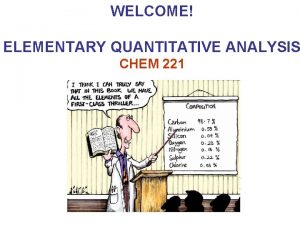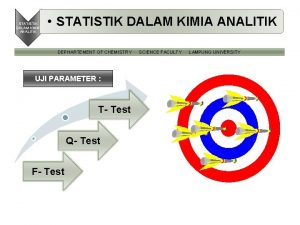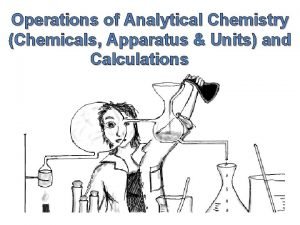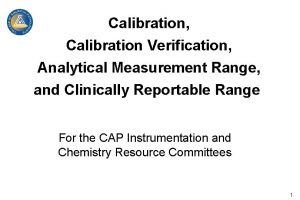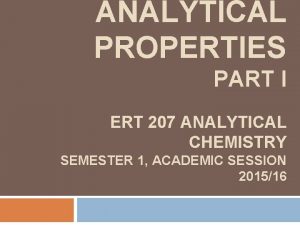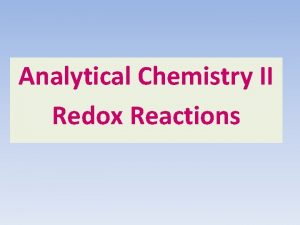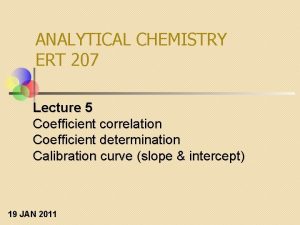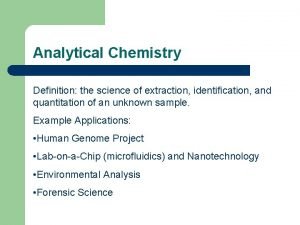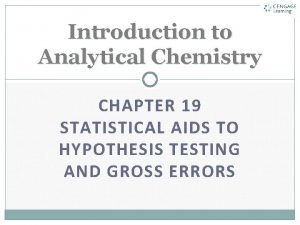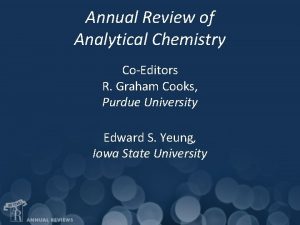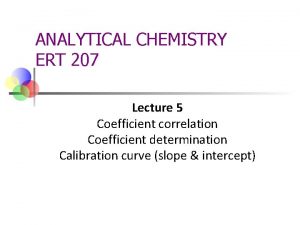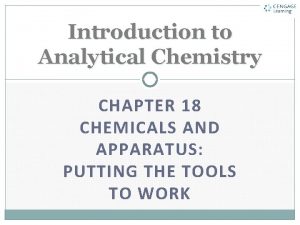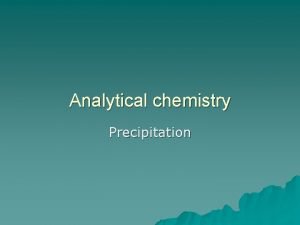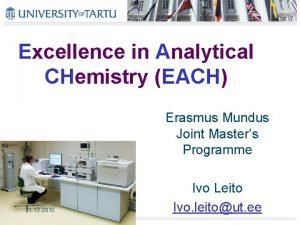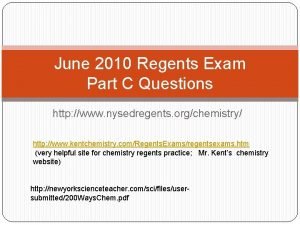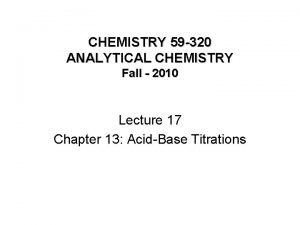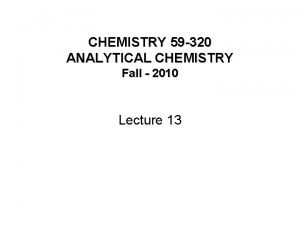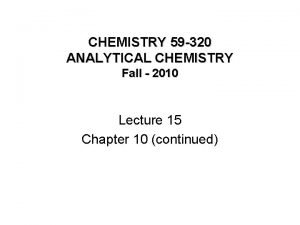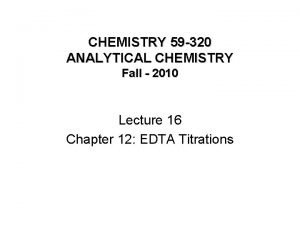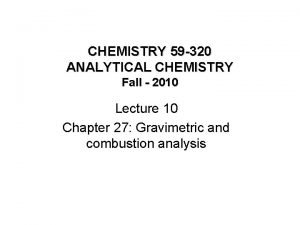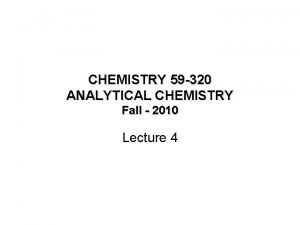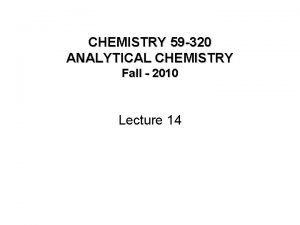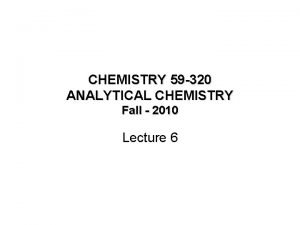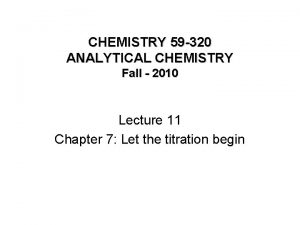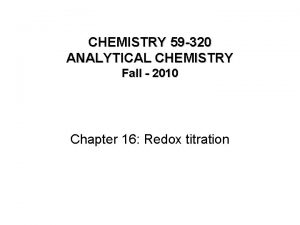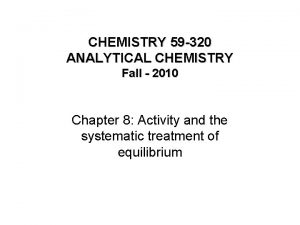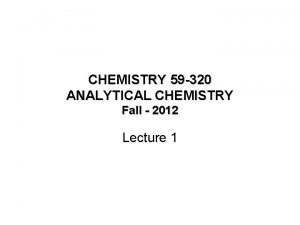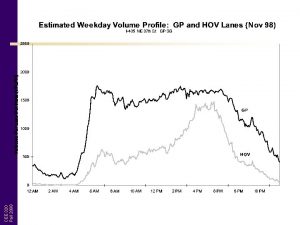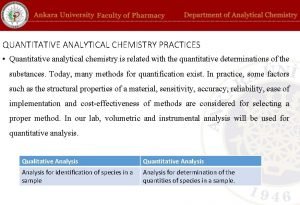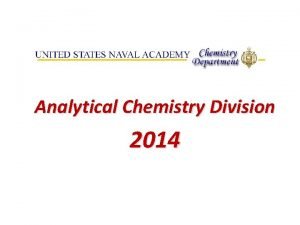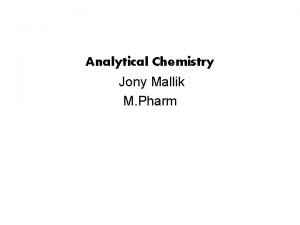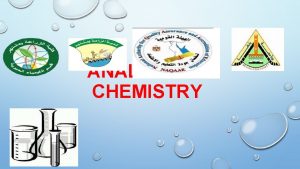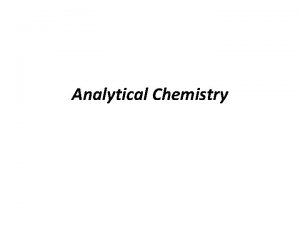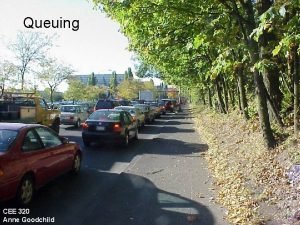CHEMISTRY 59 320 ANALYTICAL CHEMISTRY Fall 2010 Lecture






















- Slides: 22

CHEMISTRY 59 -320 ANALYTICAL CHEMISTRY Fall - 2010 Lecture 2

0 -2 General steps in a chemical analysis • An analysis involves several steps and operations which depend on: the particular problem your expertise the apparatus or equipment available. • The analyst should be involved in every step.


Sample questions #1: The steps in a chemical analysis are (a) 1. Formulate the question. 2. Select the analytical procedure. 3. Sample. 4. Prepare the sample. 5. Make replicate measurements of the sample. (b) 1. Select the analytical procedure 2. Sample. 3. Prepare the sample. 4. Make replicate measurements of the sample. 5. Make a clear and complete written report of your findings. (c) 1. Formulate the question. 2. Select the analytical procedure. 3. Sample. 4. Prepare the sample. 5. Make replicate measurements of the sample. 6. Make a clear and complete written report of your findings.

#2: When performing an analysis a chemist often uses a standard solution. What is a standard solution? (a) A solution that complies with standards established by the Environmental Protection Agency. (b) A solution that has a concentration of a chemical that is known to a high degree of certainty. (c) A solution that is prepared from a chemical that has been designated as a primary standard. #3: In a random heterogeneous material, (a) differences in composition occur randomly and on a fine scale. (b) large regions have obviously different compositions. (c) samples are collected by taking portions from the desired number of segments chosen at random.

Chapter 1: Measurements 1 -1 SI Units


Using prefixes as multipliers We customarily use prefixes for every third power of ten, e. g. 10 -9. 10 -6, 10 -3 …

Converting between units Example: Express the energy 20 Calories in terms of ? kilojoules (k. J)

1 -2 Chemical concentrations A few concepts • Solution: homogeneous mixture of two or more substances. • Solute: a minor species in a solution. • Solvent: the major species in a solution. • Concentration: how much solute is contained in a given volume or mass of solution or solvent. • Strong & weak electrolytes.

1 -2 Chemical concentrations (Continued) Molarity and Molality: Molarity (M) is the number of moles of a substance per liter of solution. Molality (m) is concentration expressed as moles of a substance per kilogram of solvent. Problem 1 -14. What is the formal concentration (expressed as mol/L = M) of Na. Cl when 32. 0 g are dissolved in water and diluted to 0. 500 L? Answer: The molecular mass of Na. Cl is 58. 44 g/mol The moles of sale in 32. 0 g are 32. 0 g /58. 44(g/mol) = ……


1. 3 Preparing solutions • Preparing a solution with a desired molarity • Dilution Problem 1 -32: A bottle of concentrated aqueous sulfuric acid labeled 98. 0 wt % H 2 SO 4, has a concentration of 18. 0 M. How Many millilitres of reagent should be diluted to 1. 000 L to give 1. 00 M H 2 SO 4? Solution:

1. 4 Stoichiometry Calculation One must make sure that the reaction equation is balanced!!

Stoichiometry Calculation (2) • Problem 1 -34: How many millilitres of 3. 00 M H 2 SO 4 are required to react with 4. 35 g of solid containing 23. 2% Ba(NO 3)2 if the reaction is Ba 2+ + SO 42 - →Ba. SO 4(s)? • Answer:

Chapter 2: Tools of the Trade • 2. 1 Safe, ethical handling of chemicals and waste -- Chemical experimentation creates hazards! -- The primary safety rule is to familiarize yourself with the hazards and then to do NOTHING that you consider to be dangerous. -- Minimize waste production and RESPONSIBLY dispose of waste. -- Recycling chemicals. -- Clean spills immediately. -- Label all vessels to indicate what they contain.


What safety information can be obtained from the following label?

2. 2 The lab notebook • State what you did and what you observed in a way that it can be understood by a stranger. • Record the names of computer files where programs and data are stored. • Copy important data into your notebook. (Computers may crash and become garbage at any time).

2. 3 Analytical balance • Tare: the mass of an empty vessel that is used to receive the substance to be weighted. • Sensitivity: the smallest increment of mass that can be measured. • Chemicals should NEVER be placed directly on the weighting pan • Handle the vessel you are weighting with a paper towel so that the tare value does not change.

Principle of operation (1)

Principle of operation (2)
 01:640:244 lecture notes - lecture 15: plat, idah, farad
01:640:244 lecture notes - lecture 15: plat, idah, farad After the fall 2010
After the fall 2010 Analysis
Analysis Sources of error in analytical chemistry
Sources of error in analytical chemistry Pemeriaan
Pemeriaan Analytical apparatus
Analytical apparatus Analytical measurement range (amr)
Analytical measurement range (amr) Normal error curve in analytical chemistry
Normal error curve in analytical chemistry Redox reaction in alkaline medium
Redox reaction in alkaline medium Correlation coefficient in analytical chemistry
Correlation coefficient in analytical chemistry Example of analytical chemistry
Example of analytical chemistry Q test in analytical chemistry
Q test in analytical chemistry Annual review of analytical chemistry
Annual review of analytical chemistry Correlation coefficient in analytical chemistry
Correlation coefficient in analytical chemistry Organic chemistry chapter 1 problem 59pp
Organic chemistry chapter 1 problem 59pp Special purpose reagent chemicals
Special purpose reagent chemicals Analytical chemistry
Analytical chemistry Excellence in analytical chemistry
Excellence in analytical chemistry Occlusion and mixed-crystal formation
Occlusion and mixed-crystal formation June 2010 chemistry regents answers
June 2010 chemistry regents answers Advanced inorganic chemistry lecture notes
Advanced inorganic chemistry lecture notes An introduction to atmospheric physics
An introduction to atmospheric physics Us history semester 1 final exam study guide answers
Us history semester 1 final exam study guide answers


